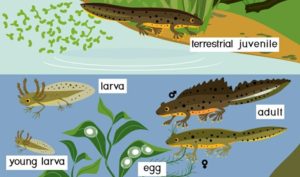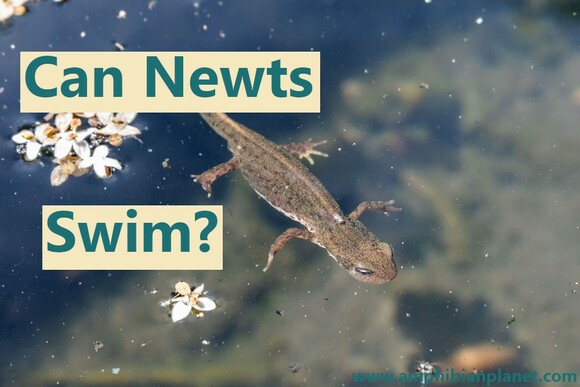Almost everyone who sees them agrees that newts are endearing little creatures. They make amusing pets and are relatively easy to maintain. However, many people have misconceptions about these little amphibians. So, can newts swim?
All newts can swim. They are semi-aquatic creatures (they live both on land and in the water) as adults and are excellent swimmers. All newts begin their lives in water and typically return to the water as adults. As such, they are natural-born swimmers.
Some newts, such as the rough-skinned newt, spend most of their adult lives on land. However, even these are excellent swimmers and will migrate to the water during the breeding season.
All Newts Start Their Lives in Water

Newts start their lives as tiny aquatic larvae, that look somewhat similar to frog tadpoles. These larvae have external feathery gills and a flat paddle-like tail fin for life in the water.
At this stage, newt larvae swim by flapping their tails from side to side, just like frog tadpoles. They will live entirely in the water, eating tiny invertebrates until they transform into adults able to live on land.
Larvae Eventually Grow Into Adults
After a few months, the larvae will go through a process known as metamorphosis which will transform them into adults.
During metamorphosis:
- Their gills are absorbed into their head, and they develop lungs for breathing air
- They develop strong legs for walking on land
- Their flat tail becomes more rounded
Once they are fully metamorphosed, they can live on land and use their lungs to breathe air. When on land they will usually spend most of their time hiding under rocks, logs, or other debris in moist environments not too far from water.
All Adult Newts Can Swim
All adult newts can swim.
Some newts such as the rough-skinned newt will live a mostly terrestrial life as adults, while others such as the Spanish ribbed newt will live a mostly aquatic life.
However, even newts that live a mostly terrestrial life will return to the water to breed. In the breeding season, these newts may develop temporal features (such as a flatter, wider tail, and fully webbed footing) to help them swim better in the water.
How Adult Salamanders Swim
Newts swim by tucking their legs against the side of their body and thrusting themselves forward by flapping their tail from side to side, very similar to how alligators swim.
Some species, like paddle-tail newts, have fully webbed feet with very short toes which makes them very efficient swimmers.
Here is a video showing eastern newts swimming underwater:
Can Newts Breathe Underwater?
Newts can breathe underwater by absorbing oxygen that comes in contact with their skin. This is known as cutaneous respiration (sometimes informally called “skin breathing”).
Their skin contains thousands of capillaries and other blood vessels very close to the skin surface. Dissolved oxygen that comes in contact with this skin is absorbed into the bloodstream via diffusion.
At the same time, carbon dioxide from the bloodstream passes through the skin and is diffused into the water
The oxygen they get from this is usually insufficient so they can only stay underwater for a limited time before they have to visit the water surface for a gulp of air.
However, when they are inactive, they can meet most of their oxygen demands through cutaneous respiration allowing them to stay underwater for a very long time.
For more in-depth information, check out this post.
How Long Can Newts Stay Underwater?
How long a newt can stay underwater depends on how much oxygen it can absorb through the skin.
This is usually determined by; the nature of the water, how active the newt is, and the newt’s skin surface area
The Nature of the Water
Fast-moving water contains more oxygen than stagnant water. This is because oxygen from the atmosphere is dissolved into the water easier. This means newts can say underwater in fast-moving water for much longer than they can in still or stagnant pools of water.
The Newts’ Skin Surface Area
The bigger the skin surface area, the more oxygen a newt can absorb from the water into its bloodstream.
For example, in crested newts, the extra surface area of skin provided by the large crest allows them to absorb more oxygen through their skin. As such, they can stay underwater for a significant amount of time.
How Active the Newt Is
Newts will have a higher oxygen demand when they are working hard (escaping a predator, for example), and a lower oxygen demand when they are at rest.
This means they can stay underwater when at rest, for much longer than you can when they are very active.
With all these factors into consideration, newts can stay underwater anywhere from a few minutes to several hours
However, during hibernation, some newts can stay underwater all winter long. This is because, during hibernation, they have very low oxygen requirements which can easily be met through cutaneous respiration (breathing through the skin).
Can Newts Drown?
Even with their ability to breathe underwater, newts can drown if they are prevented from surfacing for air. Newts have lungs, just like we humans do. If their lungs fill with water, they can drown.
You might think: but newts can through their skin, right? Yes, they can! But this alone isn’t enough. They need to surface for air to get extra oxygen.
If a newt gets into a body of water so deep that it can not surface or get out of the water, it will drown.
Related Questions
Question: Can Newts Live Out of Water?
Answer: Newts can live out of water, but some newts such as the Spanish ribbed newt are more adapted for aquatic life and can only be on land for a short period before they have to get back in the water.
Newts such as rough-skinned newts are very well adapted for a life on land. In fact, rough-skinned newts spend most of their adult lives on land, returning to the water only to breed.
Question: Can Newts Climb?
Answer: Newt can easily climb an angled surface, however, they are not very good climbers. It is nearly impossible for them to climb a vertical surface.
Question: Can Newts Jump?
Answer: Newts are adapted for walking and swimming rather than jumping. Unlike frogs or toads, they have short legs, and all their legs are about the same length.
This means they are not very good jumpers. However, they can still jump from an elevated platform onto the ground.
Conclusion
Newts are semi-aquatic creatures, meaning they live part of their lives on land, and part in the water. As such, they are natural-born swimmers.
Some newts live mostly in the water, while others live mostly on land. However, those that live on land will migrate to the water when it’s time to breed.


